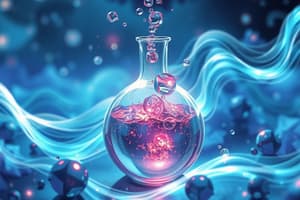Podcast
Questions and Answers
What is the homogeneous mixture formed when a solute dissolves in a solvent?
What is the homogeneous mixture formed when a solute dissolves in a solvent?
- Suspension
- Solution (correct)
- Emulsion
- Colloid
Which type of solute can dissolve in both polar and nonpolar solvents?
Which type of solute can dissolve in both polar and nonpolar solvents?
- Oils
- Gases like oxygen and carbon dioxide
- Metal ions
- Amphoteric solutes like acetic acid and ammonia (correct)
What is the primary function of solid-bed filters?
What is the primary function of solid-bed filters?
- To separate solid particles from a liquid (correct)
- To remove impurities by adsorption or mechanical trapping
- To separate particles based on their size or electrical charge
- To separate gases from polar solvents
What does molarity measure?
What does molarity measure?
Which type of solute can dissolve well in nonpolar solvents?
Which type of solute can dissolve well in nonpolar solvents?
What is the function of depth filters?
What is the function of depth filters?
What do parts per million (ppm) or parts per billion (ppb) express?
What do parts per million (ppm) or parts per billion (ppb) express?
What does solubility refer to?
What does solubility refer to?
How is solubility in water described?
How is solubility in water described?
When does the dissolving process occur?
When does the dissolving process occur?
How is solubility in a specific solvent described?
How is solubility in a specific solvent described?
What factor often increases solubility with temperature?
What factor often increases solubility with temperature?
Which process involves separating a solute from a solution by allowing the solute to form crystals?
Which process involves separating a solute from a solution by allowing the solute to form crystals?
What technique uses centrifugal force to separate particles from a liquid by spinning the mixture?
What technique uses centrifugal force to separate particles from a liquid by spinning the mixture?
What do solubility rules provide a simple framework for predicting?
What do solubility rules provide a simple framework for predicting?
Which factor can affect solubility for gaseous solutes, such as carbon dioxide dissolving in water?
Which factor can affect solubility for gaseous solutes, such as carbon dioxide dissolving in water?
What does membrane filtration use to separate particles?
What does membrane filtration use to separate particles?
Flashcards are hidden until you start studying
Study Notes
Solutions, Solubility, and Separation of Solids from Liquids: A Comprehensive Guide
On Monday, February 05, 2024, we'll be diving deep into the fascinating world of solutions, solubility, and separating solids from liquids. As we explore these subtopics, we'll seek to understand the underlying principles behind these concepts, as well as the practical applications and techniques related to them.
Dissolving Process
The dissolving process, also known as solvation, is a fundamental phenomenon in chemistry where a solid or a gaseous substance (known as a solute) gets mixed with a liquid (known as a solvent) to form a homogeneous mixture called a solution. The primary driving force for solvation is the attraction between the solute and solvent particles. These attractions are typically electrostatic interactions, hydrogen bonding, or van der Waals forces.
Solvents have unique properties that influence solubility. For instance, polar solvents like water readily dissolve polar solutes, while nonpolar solvents like hexane dissolve nonpolar solutes. This principle is captured in the like dissolves like rule.
Solubility Rules
Solubility rules provide us with useful guidelines for predicting whether a solute is soluble in a particular solvent. Here are some general solubility rules for common solutes:
-
Polar solutes in polar solvents: Solutes like salts and sugars dissolve well in polar solvents, such as water, methanol, and ethanol.
-
Nonpolar solutes in nonpolar solvents: Solutes like oils and fats dissolve well in nonpolar solvents, such as hexane and chloroform.
-
Gases in polar solvents: Gases, like oxygen and carbon dioxide, dissolve well in polar solvents like water, but not in nonpolar solvents.
-
Gases in nonpolar solvents: Gases, like hydrogen sulfide (H2S) and ammonia (NH3), dissolve well in nonpolar solvents like hexane, but not in polar solvents.
-
Amphoteric solutes: Amphoteric solutes like acetic acid and ammonia can dissolve in both polar and nonpolar solvents, depending on the context.
-
Formation of complex ions: Some solutes, like metal ions, form complex ions with solvent molecules, which can increase solubility.
Filtration Techniques
Filtration refers to the process of separating solid particles from a liquid, typically using a filter. Filters can be classified into three primary types:
-
Solid-bed filters: Solid-bed filters, like paper, cloth, or glass filters, are used for separating suspended solids.
-
Membrane filters: Membrane filters, like ultrafiltration or reverse osmosis, use semipermeable membranes to separate particles based on their size or electrical charge.
-
Depth filters: Depth filters, like activated carbon or sand filters, are used to remove impurities by adsorption or mechanical trapping.
Solute Concentration
The concentration of a solute in a solution is expressed in different ways, depending on the context:
-
Molarity (M): Molarity is the number of moles of solute per liter of solution.
-
Moles per liter (mol/L): Moles per liter is a more general unit of concentration that is not limited to a specific type of solute.
-
Percentage (%): Percentage concentration is the amount of solute in a given solution relative to the solvent.
-
Parts per million (ppm) or parts per billion (ppb): These units express concentration as the mass or moles of solute per million or billion mass units of solvent.
Understanding the concepts of solubility, separation, and solute concentration is vital for chemists and scientists working with solutions in various fields, from pharmaceuticals to environmental science. We hope this article has given you a solid foundation to explore these fascinating topics further. Happy learning!
Studying That Suits You
Use AI to generate personalized quizzes and flashcards to suit your learning preferences.




